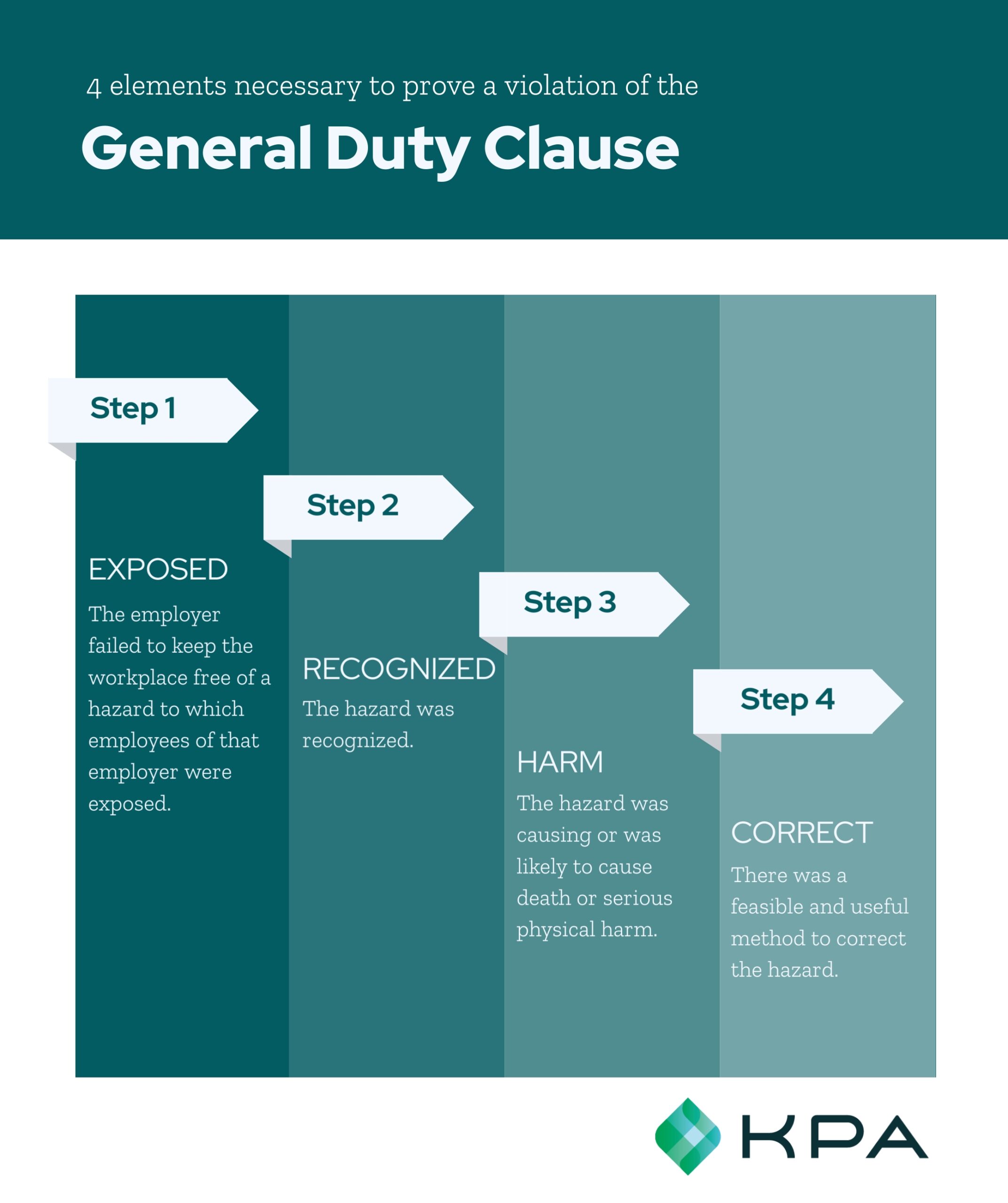So, what is the General Duty Clause? Picture this: It’s a Tuesday. Your employees are working as usual—talking to customers, typing away at their computers, loading boxes onto trucks, doing whatever it is they’re supposed to be doing on a Tuesday. All of a sudden, the power goes out. The sky turns black. The building rumbles. The fabric of reality splits open, and a writhing mass of tentacles emerges from the rift in the middle of your workplace. An unspeakable evil has trespassed into our reality. You’ve never seen anything like it before, but you recognize it immediately, instinctively, as an Ancient One.
Let’s pause for a moment, as you and your employees stand face-to-face with a horrific cosmic entity from another dimension: Do you have to do anything about this? Can you get in trouble for continuing to work as usual? Surely the Occupational Health and Safety Administration doesn’t have a rule about Cthulhu—so you’re in the clear, right?
Wrong!
What is the General Duty Clause?
Whenever something threatens the health and safety of your workers, OSHA expects you to take action against it. The agency has developed in-depth rules and guidelines for most hazards, but not everything. When the danger is unusual or unprecedented, employers must follow the General Duty Clause.
Under the OSHA General Duty Clause, the employer has an obligation to protect workers from serious and recognized workplace hazards even where there is no standard.
 Got a plan for when Cthulhu strikes?
Got a plan for when Cthulhu strikes?
Didn’t think so.
Section 5 of the Occupational Safety and Health Act of 1970 states the following:
“(a) Each employer —
(1) shall furnish to each of his employee’s employment and a place of employment which are free from recognized hazards that are causing or are likely to cause death or serious physical harm to his employees;
(2) shall comply with occupational safety and health standards promulgated under this Act.
(b) Each employee shall comply with occupational safety and health standards and all rules, regulations, and orders issued pursuant to this Act which are applicable to his own actions and conduct.
5(a)(1) is what’s commonly referred to as the General Duty Clause. If any hazard is injuring, killing, or has the potential to seriously physically harm your employees, you need to take care of it, regardless of how novel, strange, or Lovecraftian it may be.
Think of the General Duty Clause as a catch-all.
If OSHA has released specific rules and guidelines about a workplace hazard, you should obey those. Otherwise, if there’s no official documentation about the thing posing a danger to your employees, you have an obligation under the General Duty Clause to remove it from the workplace.
Note that under 5(b), your employees also have an obligation—specifically, to follow all “occupational safety and health standards and all rules, regulations, and orders” of the OSH Act that apply to their “actions and conduct” during the situation at hand.
As with every OSHA regulation, you can end up in serious trouble for violating the General Duty Clause. But that doesn’t mean you’re expected to anticipate or solve each and every conceivable (and inconceivable) hazard.

According to OSHA, 4 elements are necessary to prove a violation of the General Duty Clause (emphasis added):
1. The employer failed to keep the workplace free of a hazard to which employees of that employer were exposed;
2. The hazard was recognized;
3. The hazard was causing or was likely to cause death or serious physical harm; and
4. There was a feasible and useful method to correct the hazard.
In OSHA’s thinking, a hazard is considered recognized if the employer knew (or should have known) of its existence from previous incidents, employee complaints, failures to correct, industry standards, or if a “reasonable person” could recognize it as a hazard.
Serious hazards are those that could cause death, or “serious physical harm.” OSHA’s Field Operations Manual considers these among the list of serious injuries:
“amputations, concussion, other serious impairment (temporary or permanent, chronic or acute) of any part of the body, crushing injuries and bone fractures, burns (from any source and including scalds), and lacerations of any kind involving significant bleeding and/or requiring suturing, sprains, strains, and musculoskeletal disorders. Serious physical harm also includes illnesses such as cancer, poisoning, chronic respiratory illness (silicosis, asbestosis, byssinosis, etc.), hearing and/or visual impairment, and impairment of the central nervous system.”
Let’s Put the General Duty Guidelines to Use
Thinking back to our encounter with the cosmic horror Cthulu, let’s examine how OSHA’s General Duty Clause guidelines might apply:
1. Did the employer fail to keep the workplace free of a hazard to which employees were exposed?
We need to determine a) whether there is a hazard and b) whether it’s in the workplace and affecting employees. Both answers seem like an easy “yes.” I think it’s fair to assume that an Ancient One whipping its tentacles around is a hazard, and that people in the workplace would be exposed to that hazard.
2. Was the hazard recognized?
This, again, is pretty straightforward. The Ancient One is unearthly and perhaps indescribable, but its danger is clearly recognizable. Next.
3. Was the hazard causing—or was it likely to cause—death or serious physical harm?
I’m going to make an educated guess and say “yes.” It was certainly as likely as anything to destroy the building and tear the employees limb from limb. But, then again, maybe it was just stopping in to say hi. We can’t be totally sure, as we paused right before anything happened. Let’s roll the tape and—oh, yep—there go the screams, and the destruction, and the crushed bones, and the melting faces… Yes, definitely death and serious physical harm.
4. Was there a feasible and useful method to correct the hazard?
A-ha! Here’s where we might have an out. I can’t think of anything “feasible” or “useful” that could “correct” an Ancient One. Can you? Maybe if we had access to the Obsidian Blade of Binding—but that’s buried deep within the Wreckage of the Vanno on New Ganymede. There’s certainly nothing on this planet, or in this reality, that could have saved us.
And there you have it. Your business (and the universe as we know it) might be destroyed, but at least you don’t have to worry about an OSHA penalty. At least in this case.
Absurdity aside, the General Duty Clause is important, especially during times like these. As employers across the US contend with the similarly alien but very real horror of COVID-19, it’s vital to keep OSHA standards in mind and follow one’s obligations under the General Duty Clause. The hazard may be new—and it may be terrifying—but you still have a duty to keep your employees safe.
OSHA’s index of Safety and Health Topics lists over 150 workplace hazards. OSHA uses the General Duty Clause for hazards that may not show up on this list. issues a number of citations under the General Duty Clause for hazards not necessarily covered by a specific OSHA work safety Standard. OSHA regularly cites employers under the GDC recognized hazards like:
- COVID-19
- Extreme heat and cold
- Extreme weather (think flooding, hurricanes, or tornadoes)
- Workplace violence
- Ergonomics and musculoskeletal disorders
- Combustible dust
OSHA has put some guardrails around who it can apply the general duty clause, namely:
- General duty violations can’t be grouped together. Although they may be grouped with a related violation of a specific standard.
- General duty violations can’t be used to impose a stricter requirement than that required by a standard.
- The general duty clause can’t be used to require an abatement method not set forth in a specific standard.
- The clause can’t be used to enforce “should” standards.
- The clause can’t be used to cover categories of hazards exempted by a standard.
KPA Helps You Steer Clear From General Duty Violations
While we might not be able to protect you from ancient horrors like Cthulu, we are well versed in helping our customers steer of serious and recognized workplace hazards. KPA’s unique combination of software, consulting, and training allows organizations to automate manual processes, increase productivity, improve employee training, and reduce the overall cost of risk.
